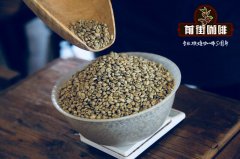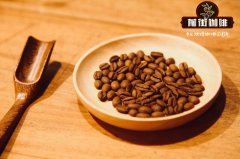Coffee beans are different from their varieties, Arabica and Robusta coffee beans.

Professional coffee knowledge exchange more coffee bean information please follow the coffee workshop (Wechat official account cafe_style)
Robusta Coffee Flavor description Grinding characteristics introduction to the taste and price of fine coffee in producing areas
Coffee beans are the seeds of coffee fruit, which are processed, roasted, ground and brewed by baristas in the factory before they become the coffee we drink. Just like drinking wine, you are drinking the grapes used in making wine, in the same way, when you drink coffee, what you are drinking is the taste of coffee beans. Since coffee beans are seeds,
Its tree species and growth environment (origin) will have a great impact on the flavor.
Grapes have been eaten. Red grapes, black grapes and white jade grapes are all grapes, but there is a great difference in taste because of their different tree species and growing environment.
Caffeine bean variety
Coffee belongs to the evergreen shrub of the genus Coffea of Rubiaceae. There are about 40 species of plants under the branch of Coffea.
There are only three kinds of coffee of commercial value:
Arabica species (Coffea Arabica) (yield: 69%)
Robusta species (Coffea Robusta) (yield: 30%)
Liberian species (Coffea Liberica) (yield: 1%)
These three varieties are called the "three native species of coffee".
Arabica (Arabica), Robusta (Robusta), Liberia (Liberica)
And there are many kinds of coffee.
The classification standard of biological taxonomy is to name an organism according to "realm, phylum, class, order, family, genus, species". It can also be divided into "secondary species", "variety" and "variety". Among them, there are mutant varieties that appear in natural evolution, while others are deliberately cultivated into varieties with special needs.
Coffee family picture original from:Coffee Family Tree
Since Liberia accounts for less than 1%, only Arabica and Robusta are introduced.
Arabica (Arabica):
In fact, there are thousands of different "secondary species" and "varieties" under this species name.
The more representative varieties of Arabica are:
Varieties closest to the original species: Typica, Bourbon (bourbon)
Well-known Typica variants: Maragogype (Giant Elephant Bean), Geisha (nicknamed geisha bean … Because it is homonym with [geisha])
Well-known Bourbon variants: Caturra (Kaddura), Pacas (Parks)
Well-known mixed race breed:
Typica (Tibica) and Bourbon (bourbon) are mixed. [Mundo Novo] Mondonovo species
Maragogype (giant elephant bean) and Pacas (Parks) are mixed. [Pacamara] Parkmara species
Caturra (Kaddura) and Mundo novo (Mondonova species) were mated. [Catuai] Katuai seed
Timor was mixed with Caturra. [Catimor] Cartimo species
* Timor is the mating species of Arabica and Robusta.
Robsta species (Coffea Robusta):
In fact, it is a mutant of Coffea C anephora.
Arabica species account for about 70% of the world's total production, and boutique coffee is in large demand. Robusta species account for 20%, 30%, and are mainly used in instant coffee, canned coffee, sweetness and oil lower than Arabica, and the content of caffeine is twice that of Elaraby. Liberian species are only traded in Suriname, Libya, C ô te d'Ivoire and other countries in West Africa because they are not resistant to leaf rust and have a poor flavor, but are not popular all over the world.
Producing area of caffeine beans
Coffee grows mainly in tropical or subtropical continental or island coffee plantations in America, Africa and Asia.
Coffee is mainly grown at 23.5 degrees north and south latitude.
So along the equator as the center of the coffee growth belt, also known as the coffee belt.
Coffee belt
Blue Mountain Coffee (belonging to Arabica)
It is produced in the Blue Mountains of Jamaica, a tropical island in the Caribbean. Its caffeine content is very low, less than half of the coffee from other producing areas, and the unique flavor of "Blue Mountain Coffee" is related to the unique geographical location and climatic conditions of the Blue Mountain region of Jamaica.
In the Blue Mountains of Jamaica, there is black and fertile new volcanic soil, fresh air and almost no pollution. It rains all the year round and there is a big temperature difference between day and night in this area. And because of the special geographical environment here, every afternoon, clouds cover the top of the Blue Mountain, not only blocking the sun for coffee trees, but also bringing abundant water vapor, which is the basis of such geographical location. The taste and aroma of Blue Mountain coffee is unique to the coffee produced all over the world, so its output is very small and often exceeds demand. Not all the coffee produced in the whole Blue Mountain area can be called Blue Mountain Coffee. Only the coffee grown in the Blue Mountain area above 1800 meters above sea level can be called Blue Mountain Coffee.
Manning Coffee (belonging to Arabica)
The "Mantenin" coffee produced on the Indonesian island of Sumatra is also very popular with Taiwanese consumers. "Mantenin" is actually the name of a local ethnic group in Sumatra. Coffee has been grown in Sumatra, Indonesia since the 18th century, but it has not been noticed by the outside world. In the 1950s, Japanese soldiers stationed there accidentally drank coffee from the local "Sumatra" and asked coffee vendors about the name of the coffee. The vendors mistakenly thought that the Japanese soldiers asked "what nationality are you?" so they answered "Manning." Mantenin belongs to deep-roasted coffee beans, full-bodied, thick and mellow, suitable for sweet and bitter taste, supple without sour taste, and strong mellowness is the best choice for tasting heavy coffee.
The "Sumatra manning" cultivated by the delicate production management process in Japan has a new name-"Golden Manning".
Brazilian coffee (belonging to Arabica)
Rich in coffee bean exporter Brazil, the production of coffee beans, the best selection is called "Brazilian coffee". Brazilian coffee ranks first in coffee production in the world. Formal coffee cultivation began around 1850 and coffee trees were planted in Sao Paulo in southeastern Brazil. Now the main producing area is centered on the south. The soil is reddish purple and weathered basalt. When the soil is dry, it is brown, fertile and well drained, so it is suitable for coffee growth. "Brazilian Coffee" has a strong sour taste, with the original sweet and bitter taste of coffee, the entrance is very smooth, and with a hint of grass aroma, slightly bitter in the fragrance, smooth and smooth, is acceptable to most people.
Colombian coffee (belonging to Arabica)
Colombia's main coffee is cultivated in the Andes, around 1300 meters above sea level on the slope, the temperature is about 7 to 18 degrees, while the annual rainfall is 2000 to 3000 meters. The soil is weakly acidic and well drained, and the climate and geology are very suitable for coffee growth. Roasted coffee beans give off a sweet smell, taste good, have a unique sour taste, and are often used in high-grade mixed coffee because of their moderate concentration.
Coffee beans produced in different countries (even in different regions and farms in the same country) vary greatly in flavor and characteristics. So you can choose the variety and origin of coffee beans to drink according to your preferences (acceptable acidity, sweetness and flavor intensity).
Manning's Robusta pedigree, Arabica beans or Katim or Katim?
Important Notice :
前街咖啡 FrontStreet Coffee has moved to new addredd:
FrontStreet Coffee Address: 315,Donghua East Road,GuangZhou
Tel:020 38364473
- Prev

Coffee fans must not know! Legendary Coffee Story of Arabica and Robusta
Professional coffee knowledge exchange more coffee bean information please follow the coffee workshop (Wechat official account cafe_style) Robusta coffee flavor description characteristics of grinding characteristics of fine coffee varieties of coffee taste price introduction [the birth of coffee beans] coffee fans must know! The legendary Coffee Story of Arabica and Robusta who likes coffee have you ever thought about the origin of coffee? It turns out that Elaraby
- Next

What is robusta coffee? How to quickly identify robusta and Arabica coffee beans?
Professional coffee knowledge exchange more coffee bean information please follow the coffee workshop (Wechat official account cafe_style) Robusta coffee flavor description abrasion characteristics varieties of fine coffee taste price introduction of coffee friends you must know that there are three major varieties in the market the most are Robusta and Arabica do you know how to identify Robusta's picture search results
Related
- Detailed explanation of Jadeite planting Land in Panamanian Jadeite Manor introduction to the grading system of Jadeite competitive bidding, Red bid, Green bid and Rose Summer
- Story of Coffee planting in Brenka region of Costa Rica Stonehenge Manor anaerobic heavy honey treatment of flavor mouth
- What's on the barrel of Blue Mountain Coffee beans?
- Can American coffee also pull flowers? How to use hot American style to pull out a good-looking pattern?
- Can you make a cold extract with coffee beans? What is the right proportion for cold-extracted coffee formula?
- Indonesian PWN Gold Mandrine Coffee Origin Features Flavor How to Chong? Mandolin coffee is American.
- A brief introduction to the flavor characteristics of Brazilian yellow bourbon coffee beans
- What is the effect of different water quality on the flavor of cold-extracted coffee? What kind of water is best for brewing coffee?
- Why do you think of Rose Summer whenever you mention Panamanian coffee?
- Introduction to the characteristics of authentic blue mountain coffee bean producing areas? What is the CIB Coffee Authority in Jamaica?

